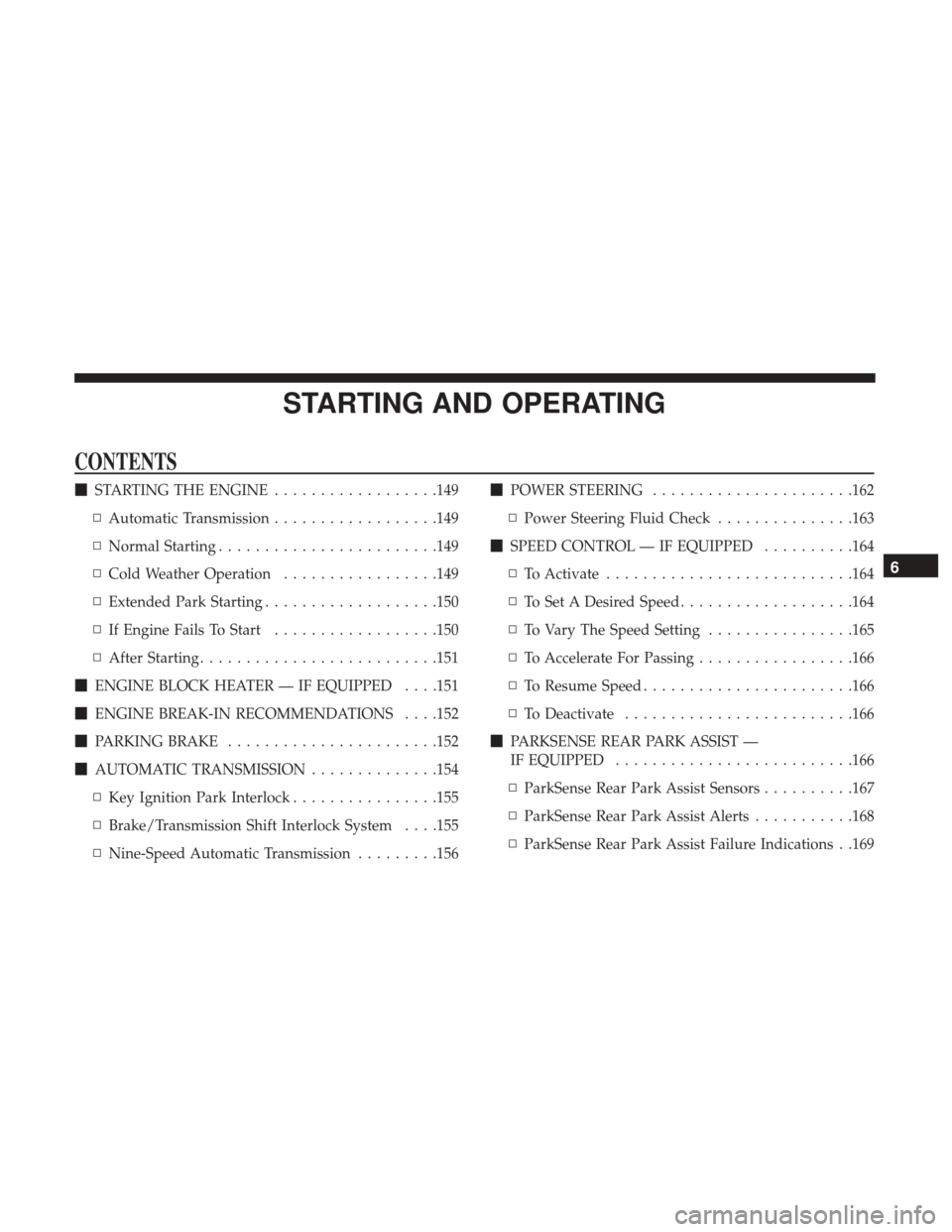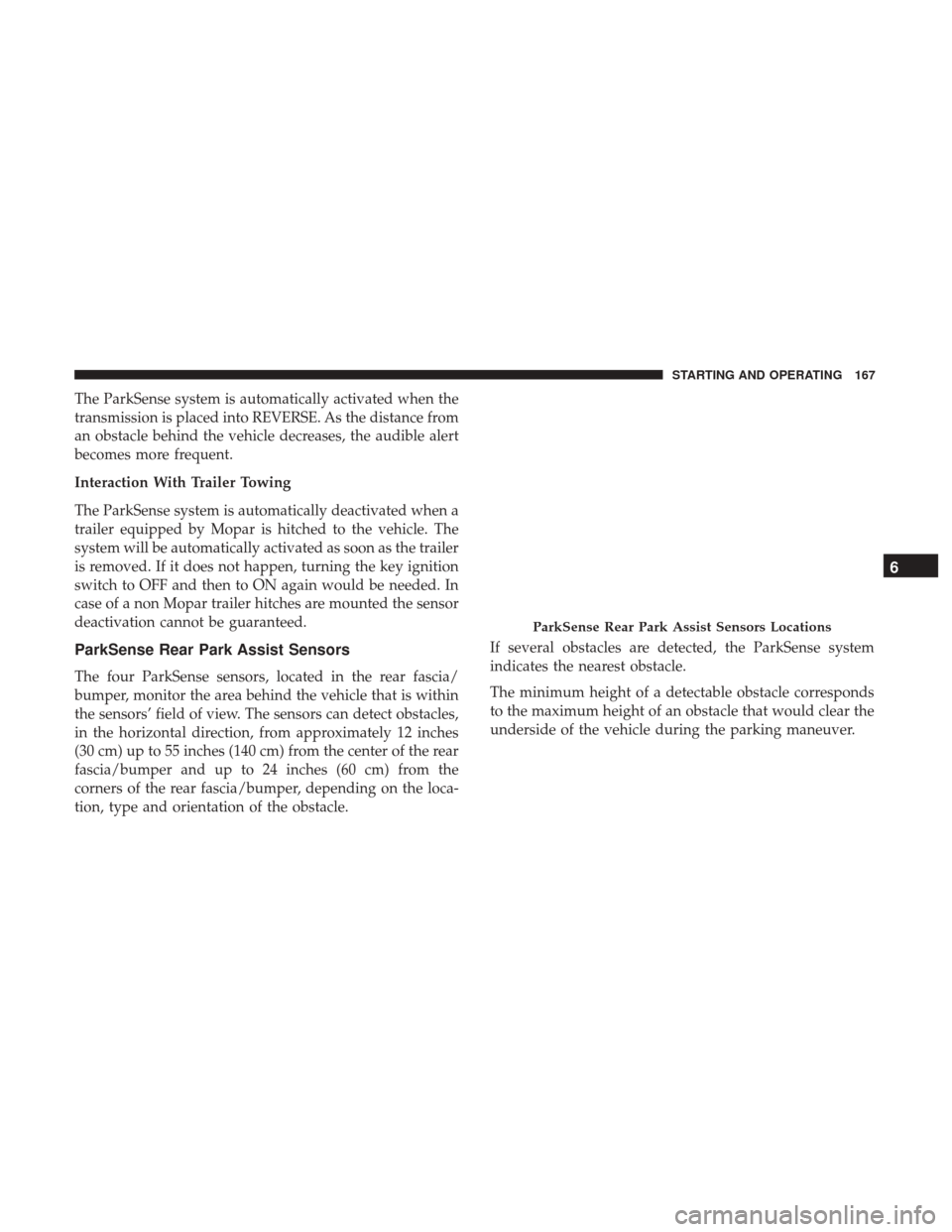Page 57 of 348

the vehicle is equipped with rear power windows, a single
opening and closing switch on the rear passenger doors for
passenger window control is provided.
NOTE:The key off power delay feature will allow the
power windows to operate for up to three minutes after the
ignition is turned OFF. This feature is cancelled when
either front door is opened.
The window opening mechanism is fitted with sensors that
can detect the presence of an obstacle whilst the window is
closing. When this happens, the system activates and the
movement of the glass is immediately reversed.
If the presence of an object is detected and the system is
activated, it may be necessary to perform the reset proce-
dure by fully opening the windows.
WARNING!
•Never leave children alone in a vehicle, or with access
to an unlocked vehicle. Allowing children to be in a
vehicle unattended is dangerous for a number of
reasons. A child or others could be seriously or fatally
injured. Children should be warned not to touch the
parking brake, brake pedal or the gear selector.
(Continued)
WARNING! (Continued)
•Do not leave the key fob in or near the vehicle or in
a location accessible to children. A child could oper-
ate power windows, other controls, or move the
vehicle.
Auto-Down Feature
The window switches are equipped with an Auto-Down
feature. Push the window switch for half a second, release,
and the window will go down automatically.
To stop the window from going all the way down during
the auto-down operation, pull up or push down on the
switch briefly.
To open the window part way, lift the window switch to
the detent for less than half a second and release it to stop
the window.
NOTE: The power window switches remain active for up
to three minutes after the ignition switch has been turned
OFF. Opening either of the vehicle’s front doors will cancel
this feature.
3
GETTING TO KNOW YOUR VEHICLE 55
Page 149 of 348

STARTING AND OPERATING
CONTENTS
�STARTING THE ENGINE ..................149
▫ Automatic Transmission ..................149
▫ Normal Starting ....................... .149
▫ Cold Weather Operation .................149
▫ Extended Park Starting ...................150
▫ If Engine Fails To Start ..................150
▫ After Starting ......................... .151
� ENGINE BLOCK HEATER — IF EQUIPPED . . . .151
� ENGINE BREAK-IN RECOMMENDATIONS . . . .152
� PARKING BRAKE ...................... .152
� AUTOMATIC TRANSMISSION ..............154
▫ Key Ignition Park Interlock ................155
▫ Brake/Transmission Shift Interlock System . . . .155
▫ Nine-Speed Automatic Transmission .........156�
POWER STEERING ..................... .162
▫ Power Steering Fluid Check ...............163
� SPEED CONTROL — IF EQUIPPED ..........164
▫ To Activate .......................... .164
▫ To Set A Desired Speed ...................164
▫ To Vary The Speed Setting ................165
▫ To Accelerate For Passing .................166
▫ To Resume Speed ...................... .166
▫ To Deactivate ........................ .166
� PARKSENSE REAR PARK ASSIST —
IF EQUIPPED ......................... .166
▫ ParkSense Rear Park Assist Sensors ..........167
▫ ParkSense Rear Park Assist Alerts ...........168
▫ ParkSense
Rear Park Assist Failure Indications . .169
6
Page 169 of 348

The ParkSense system is automatically activated when the
transmission is placed into REVERSE. As the distance from
an obstacle behind the vehicle decreases, the audible alert
becomes more frequent.
Interaction With Trailer Towing
The ParkSense system is automatically deactivated when a
trailer equipped by Mopar is hitched to the vehicle. The
system will be automatically activated as soon as the trailer
is removed. If it does not happen, turning the key ignition
switch to OFF and then to ON again would be needed. In
case of a non Mopar trailer hitches are mounted the sensor
deactivation cannot be guaranteed.
ParkSense Rear Park Assist Sensors
The four ParkSense sensors, located in the rear fascia/
bumper, monitor the area behind the vehicle that is within
the sensors’ field of view. The sensors can detect obstacles,
in the horizontal direction, from approximately 12 inches
(30 cm) up to 55 inches (140 cm) from the center of the rear
fascia/bumper and up to 24 inches (60 cm) from the
corners of the rear fascia/bumper, depending on the loca-
tion, type and orientation of the obstacle.If several obstacles are detected, the ParkSense system
indicates the nearest obstacle.
The minimum height of a detectable obstacle corresponds
to the maximum height of an obstacle that would clear the
underside of the vehicle during the parking maneuver.
ParkSense Rear Park Assist Sensors Locations
6
STARTING AND OPERATING 167
Page 172 of 348

Failure to do so can result in the system not working
properly. The ParkSense system might not detect an
obstacle behind the fascia/bumper, or it could provide a
false indication that an obstacle is behind the fascia/
bumper.
• Objects such as bicycle carriers, etc., must not be placed
within 12 inches (30 cm) from the rear fascia/bumper
while driving the vehicle. Failure to do so can result in
the system misinterpreting a close object as a sensor
problem, causing a failure indication to be displayed in
the instrument cluster display.
WARNING!
• Drivers must be careful when backing up even when
using ParkSense. Always check carefully behind
your vehicle, look behind you, and be sure to check
for pedestrians, animals, other vehicles, obstructions,
and blind spots before backing up. You are respon-
sible for safety and must continue to pay attention to
your surroundings. Failure to do so can result in
serious injury or death.
• Before using ParkSense, it is strongly recommended
that the ball mount and hitch ball assembly is
(Continued)
WARNING! (Continued)
disconnected from the vehicle when the vehicle is
not used for towing. Failure to do so can result in
injury or damage to vehicles or obstacles because the
hitch ball will be much closer to the obstacle than the
rear fascia when the loudspeaker sounds the con-
tinuous tone. Also, the sensors could detect the ball
mount and hitch ball assembly, depending on its size
and shape, giving a false indication that an obstacle
is behind the vehicle.
CAUTION!
•ParkSense is only a parking aid and it is unable to
recognize every obstacle, including small obstacles.
Parking curbs might be temporarily detected or not
detected at all. Obstacles located above or below the
sensors will not be detected when they are in close
proximity.
• The vehicle must be driven slowly when using
ParkSense in order to be able to stop in time when an
obstacle is detected. It is recommended that the
driver looks over his/her shoulder when using
ParkSense.
170 STARTING AND OPERATING